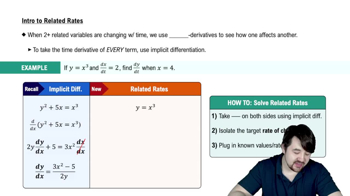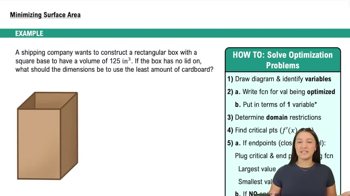If x = y³ – y and dy/dt = 5, then what is dx/dt when y = 2?
Table of contents
- 0. Functions7h 54m
- Introduction to Functions16m
- Piecewise Functions10m
- Properties of Functions9m
- Common Functions1h 8m
- Transformations5m
- Combining Functions27m
- Exponent rules32m
- Exponential Functions28m
- Logarithmic Functions24m
- Properties of Logarithms36m
- Exponential & Logarithmic Equations35m
- Introduction to Trigonometric Functions38m
- Graphs of Trigonometric Functions44m
- Trigonometric Identities47m
- Inverse Trigonometric Functions48m
- 1. Limits and Continuity2h 2m
- 2. Intro to Derivatives1h 33m
- 3. Techniques of Differentiation3h 18m
- 4. Applications of Derivatives2h 38m
- 5. Graphical Applications of Derivatives6h 2m
- 6. Derivatives of Inverse, Exponential, & Logarithmic Functions2h 37m
- 7. Antiderivatives & Indefinite Integrals1h 26m
- 8. Definite Integrals4h 44m
- 9. Graphical Applications of Integrals2h 27m
- 10. Physics Applications of Integrals 3h 16m
- 11. Integrals of Inverse, Exponential, & Logarithmic Functions2h 31m
- 12. Techniques of Integration7h 41m
- 13. Intro to Differential Equations2h 55m
- 14. Sequences & Series5h 36m
- 15. Power Series2h 19m
- 16. Parametric Equations & Polar Coordinates7h 58m
4. Applications of Derivatives
Related Rates
Problem 3.8.11a
Textbook Question
If the original 24 m edge length x of a cube decreases at the rate of 5 m/min, when x = 3 m at what rate does the cube’s
a. surface area change?
 Verified step by step guidance
Verified step by step guidance1
Identify the formula for the surface area of a cube, which is given by \( S = 6x^2 \), where \( x \) is the edge length of the cube.
Differentiate the surface area \( S \) with respect to time \( t \) to find the rate of change of the surface area. Use the chain rule: \( \frac{dS}{dt} = \frac{d}{dt}(6x^2) = 12x \frac{dx}{dt} \).
Substitute the given rate of change of the edge length \( \frac{dx}{dt} = -5 \) m/min into the differentiated equation. This negative sign indicates that the edge length is decreasing.
Substitute \( x = 3 \) m into the equation \( \frac{dS}{dt} = 12x \frac{dx}{dt} \) to find the rate of change of the surface area when the edge length is 3 m.
Calculate the expression \( 12 \times 3 \times (-5) \) to determine the rate at which the surface area is changing at the moment when \( x = 3 \) m.
 Verified video answer for a similar problem:
Verified video answer for a similar problem:This video solution was recommended by our tutors as helpful for the problem above
Video duration:
3mPlay a video:
Was this helpful?
Key Concepts
Here are the essential concepts you must grasp in order to answer the question correctly.
Related Rates
Related rates involve finding the rate at which one quantity changes with respect to another. In this problem, we need to determine how the surface area of a cube changes as its edge length changes over time. This requires understanding how to differentiate equations with respect to time, often using the chain rule.
Recommended video:

Intro To Related Rates
Surface Area of a Cube
The surface area of a cube is calculated as 6x^2, where x is the length of an edge. Understanding this formula is crucial because it allows us to express the surface area in terms of x, which can then be differentiated to find the rate of change of the surface area as x changes.
Recommended video:

Example 1: Minimizing Surface Area
Chain Rule in Differentiation
The chain rule is a fundamental technique in calculus used to differentiate composite functions. In this context, it helps us find the derivative of the surface area with respect to time by relating it to the derivative of the edge length with respect to time. This is essential for solving related rates problems where variables are interdependent.
Recommended video:

Intro to the Chain Rule

 4:16m
4:16mWatch next
Master Intro To Related Rates with a bite sized video explanation from Patrick
Start learningRelated Videos
Related Practice
Textbook Question
